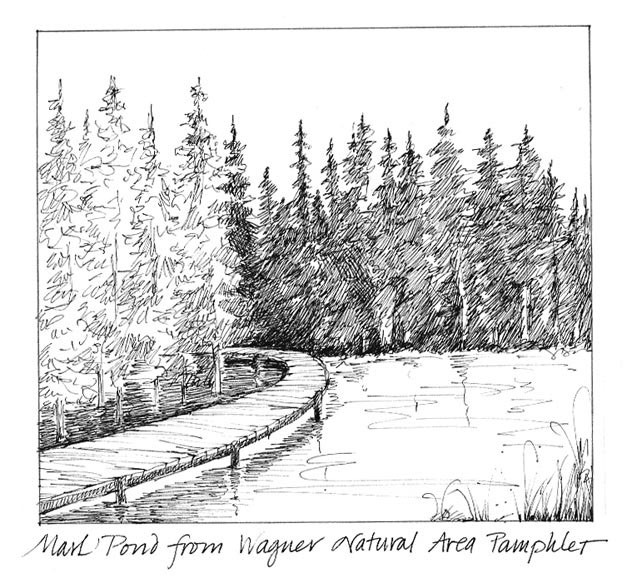
“Lime, lime, and nothing more
makes fathers rich and sons poor.”
This adage hearkens back to times when soil fertility was poorly understood; farmers who worked acidic soils discerned that the addition of lime made their crops grow better, at least for awhile. Continued applications, however, without attention to organic matter and other nutrients, eventually drained the soil of its fertility.
Back then, lime was often hard to come by. Limestone, the most common source of lime, was either not found locally or else difficult to mill into particles that would dissolve and sweeten soil. One solution that farmers used, in some places, was to dig something called “marl” out of small ponds known as “marl ponds.”
Marl consists of calcium carbonate, generally mixed with clay. It’s usually formed in freshwater ponds or lakes where calcium is a significant component of the surrounding bedrock. Marl also frequently contains calcium compounds derived from algae that has grown and decayed over centuries in these unusual ponds.
Scattered about the Northeast, marl ponds are a curious phenomenon. They are usually kettle ponds, small ponds formed when massive chunks of ice fell from melting glaciers and left indentations in the ground whose bottoms were impervious enough that the indentations became permanent water bodies. If the surrounding bedrock contains enough calcium, these ponds slowly develop linings of leached calcium carbonate. Most water bodies in Vermont and New Hampshire tend to be acidic (and are becoming more so because of acid rain), with pH levels between 4 and 7. (A pH of 7 is neutral on the acid/alkaline scale.) But water in a marl pond may have a pH of 8 or higher.
An extraordinary example is Lime or Marl Pond, just southeast of Columbia, New Hampshire, on the Connecticut River. Its bottom holds 6 feet of nearly pure, white marl, made up largely of shells of freshwater mollusks known as cyclas and planorbis that still live in the pond, usually under loose stones. The bedrock surrounding the pond is an impure, gray and blue limestone from which the calcium that defines the pond has leached over the past 10,000 years.
Other examples of marl ponds in the area include Lime Pond in Danville, Vermont, at the headwaters of a small tributary of the Water Andric, and Birch Lane Fen in Williamstown, Vermont. In Willoughby State Forest in Sutton, Vermont, Marl Pond is among the best known example of this unusual water body. This pond, like many others, was once mined for fertilizer. Surrounding the Sutton pond is a magnificent northern white-cedar swamp that has clearly benefited from the sweetness of the area’s soils.
Scientists who study natural communities are still finding marl ponds tucked away in forgotten corners of our region’s forests. Some of these ponds may once have been known for their ability to sweeten farm fields by the use of their marl, but once that practice gave way to commercial soil amendments, their special properties were forgotten, and they became just old ponds in the woods.
Marl ponds often have a light to nearly pure white bottom, though they may be darker when nearby dark-colored sediments enter the pond in runoff. The water in marl ponds tends to be quite clear, making their often light-colored bottoms even more striking.
Despite being such a great source of lime for improving agricultural fields, marl ponds themselves are generally classified as “oligotrophic,” or nutrient-poor. Very high pH levels in the ponds affect nutrient levels, especially phosphorus, by making them chemically unavailable to plant or microbial life. As a result, normal pond vegetation, such as cattails and water lilies, is either sparse or not present. A more typical (and acidic) pond supports vegetation that decays, consumes available oxygen, and eventually fills in the pond, making it into a bog or marsh. Known as eutrophication, this filling process adds nutrients and accelerates vegetative growth; eutrophic (nutrient-rich) is the opposite of oligotrophic.
Because marl ponds don’t fill in as readily, they can be surprisingly deep. Local legend has it that Lime Pond in Danville is “bottomless” and is a deep, watery grave for mysteriously lost cattle and other vanished treasures.
Perhaps your own backwoods wanderings might uncover an unknown or forgotten marl pond. If you find one, consider, for variety’s sake, calling it something other than “Marl Pond” or “Lime Pond.” And with lime being readily available at the garden store and much less expensive than in times of old, you can leave these rare and spectacular ponds in their natural condition, rather than mining their bottoms. Thus we might revise the old adage: “Lime, lime, buy it at the store. But don’t spend too much, or your kids will be poor.”

